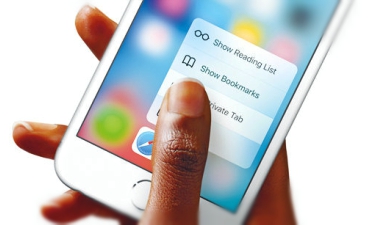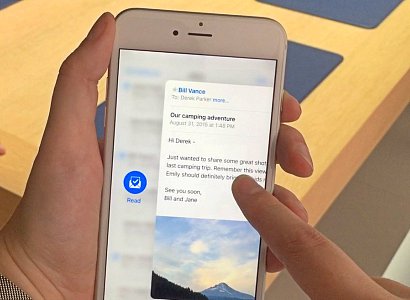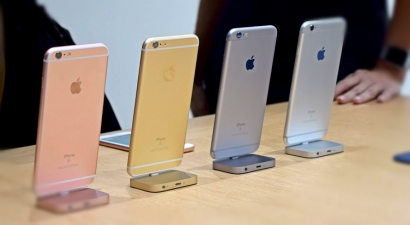Thinking of splurging on the new iPhone 6s or 6s Plus, but not sure if it’s worth the upgrade? Here’s a helpful quick rundown on the differences between the iPhone 6s vs iPhone 6 and the new iPhone 6s Plus vs last year’s 6 Plus.
 iPhone 6s vs iPhone 6 screens
iPhone 6s vs iPhone 6 screens
The most hyped new feature on the new iPhones is Apple’s 3D Touch, which uses “taptic” sensors that sense how hard you press the display–such as for quick-touch shortcuts for frequently used functions or apps.
Although Apple started calling its iPhone displays “HD Display” last year, it hasn’t actually changed the display resolution since the iPhone 5s two years ago. In other words, the new 6s is still the same 326 ppi resolution as the two-year-old 5s. And though the new 6S Plus is still the same 401 ppi as last year’s 6 Plus, that’s still a bit sharper than on the smaller 4.7-inch iPhone. This may not matter for iPhone 6s sales anyway, since most people scarcely notice the difference with resolutions that high.
iPhone 6s vs iPhone 6 cameras
 Thankfully, Apple has finally bumped up its “iSight” camera to 12 megapixels (from 8 MP the previous two years), and you can now choose to record video in “4K” (3840 by 2160) at 30 fps (frames per second) while at the same time taking still photos of up to 8 megapixels. And in keeping with the selfie trend, the front-facing FaceTime camera has been bumped to 5 megapixels from last year’s 1.2 MP, and now features “Retina Flash”.
Thankfully, Apple has finally bumped up its “iSight” camera to 12 megapixels (from 8 MP the previous two years), and you can now choose to record video in “4K” (3840 by 2160) at 30 fps (frames per second) while at the same time taking still photos of up to 8 megapixels. And in keeping with the selfie trend, the front-facing FaceTime camera has been bumped to 5 megapixels from last year’s 1.2 MP, and now features “Retina Flash”.
The latest iSight camera also a cool new “Live Photos” function that makes a 3-second video out of each photo you take. If you enable the Live Photos function, it will capture 1.5 seconds of video and audio before and after your photo. Each Live Photo takes up about twice as many megabytes as a regular photo, but don’t worry–you can store your Live Photos in your iCloud account instead of on your phone. Update: check out this new Associated Press story for details about how to use this feature.
 Other differences
Other differences
The new iPhones are powered by Apple’s latest A9 processor, which is faster than last year’s A8 chip, but doesn’t use any more power. That said, battery life is about he same–with up to 12 hours of continuous web browsing or 14 hours of video playback on the larger Plus phone, and still about 10-11 hours of web or video on the smaller 6s or 6.
Although the new iPhones are not heavy compared to some similarly spec’ed phones, they are a bit heavier than last year’s models. The iPhone 6s weighs in at 143 grams (5.04 ounces), while the iPhone 6 was just 129 grams (4.55 ounces), and the 6s Plus tips the scales at 192 grams (6.77 ounces) versus the old 6 Plus at 172 grams (6.07 ounces).
The new iPhones come with Apple’s latest operating system–iOS 9, which includes better security (according to Apple), more efficient Siri assistance and searching, a redesigned Notes app, more detailed transit information in Maps, and an all-new News app. The latest iOS also requires less space to install software updates.
 The new iPhones also come in 128GB models, which allows plenty of storage for new apps and other downloaded content. And if you’re sick of the previous iPhones’ silver and slate gray colors, you can now opt for gold or rose gold with the new iPhones.
The new iPhones also come in 128GB models, which allows plenty of storage for new apps and other downloaded content. And if you’re sick of the previous iPhones’ silver and slate gray colors, you can now opt for gold or rose gold with the new iPhones.
You can find a complete detailed comparison chart of the iPhone 6s vs iPhone 6 vs 5s–as well as the 6s Plus vs 6 Plus–on Apple’s website here.
iPhone 6s & 6s Plus availability
Apple says that most Apple stores now have the iPhone 6s and 6s Plus in stock for walk-in customers, but it’s a good idea to first reserve one from the store via Apple’s website before you go pick it up. In the US, the new iPhones are also available from all major carriers and from big-box retailers including Best Buy, Target and Walmart.
All Apple stores are offering new phone customers free “personal setup” service, in which an employee will help you customize your phone, set up email, and explain new apps. Apple is also going the extra mile to promote the new iPhones and iOS 9 through free workshops at all Apple retail stores worldwide. With these services such no-brainers for marketing and customer service, you have to wonder why other phone makers haven’t yet offered them.
In the US, Apple this year is also introducing its yearly iPhone Upgrade Program, which lets you choose a carrier and get an unlocked iPhone 6s or iPhone 6s Plus and then upgrade each year to get a new iPhone with AppleCare+ after trading in your “old” iPhone. Monthly payments on the plan start at $32 for the iPhone 6s and $37 for the 6s Plus. You can only get the upgrade program from Apple stores and authorized resellers.
Beginning Friday, October 9, the iPhone 6s and 6s Plus will officially launch in more than 40 more countries and territories: Andorra, Austria, Belgium, Bosnia, Bulgaria, Croatia, Czech Republic, Denmark, Estonia, Finland, Greece, Greenland, Hungary, Iceland, Ireland, Isle of Man, Italy, Latvia, Liechtenstein, Lithuania, Luxembourg, Maldives, Mexico, Monaco, Netherlands, Norway, Poland, Portugal, Romania, Russia, Slovakia, Slovenia, Spain, Sweden, Switzerland and Taiwan.
On October 10, you can also get the new iPhones in Bahrain, Jordan, Kuwait, Qatar, Saudi Arabia and United Arab Emirates; and on Friday, October 16, the new iPhones will become officially available in India, Malaysia and Turkey.
Apple expects the new iPhones will be available in over 130 countries by the end of the year.




